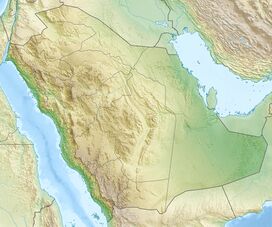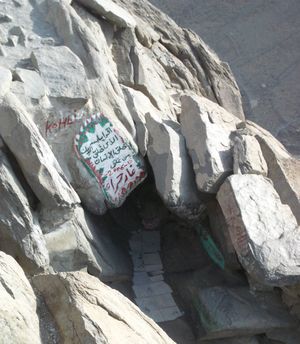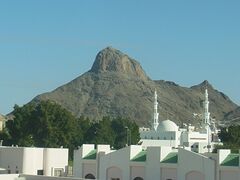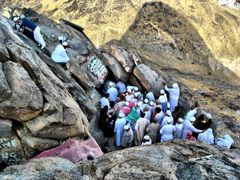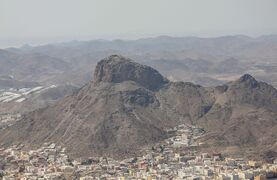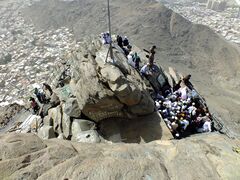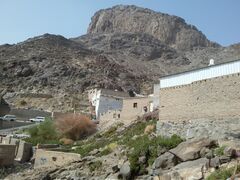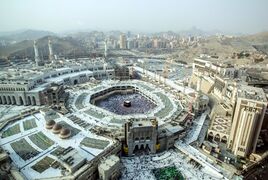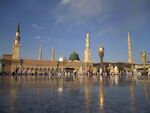جبل النور
| جَبَل ٱلنُّوْر | |
|---|---|
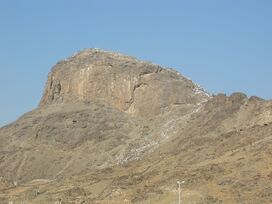 جبل النور بجوار مكة المكرمة. | |
| أعلى نقطة | |
| الارتفاع | 642 m (2،106 ft) |
| الإحداثيات | 21°27′29″N 39°51′41″E / 21.45806°N 39.86139°E |
| الجغرافيا | |
| Location | منطقة مكة، الحجاز، السعودية |
| السلسلة الأم | جبال الحجاز |
جَبَل ٱلنُّوْر، هو جبل يقع بالقرب من مكة المكرمة في منطقة الحجاز بالسعودية.[1] يضم جبل النور غار حراء، الذي نزل فيه الوحي على النبي محمد لأول مرة،.[2] يعتبر جبل النور من أهم المعالم السياحية في مكة المكرمة. يصل ارتفاع الجبل 640 متراً، إلا أن رحلة الصعود إلى غار حراء تستغرق من ساعة إلى ساعتين.
التسمية
This is where Muhammad is said to have had his first revelation and received five verses of the Quran, the mountain was given the title Jabal an-Nūr ("Mountain of the Light" or "Mountain of the Enlightenment"). This experience is sometimes identified with the beginning of revelation; hence the present name.[3] The date of the first revelation is said to be during the night on August 10, 610 A.D. Or, Monday the 21st of Ramadan,[بحاجة لمصدر] making Muhammad 40 lunar years, 6 months and 12 days of age, i.e. 39 solar years, 3 months and 22 days.[4]
الوصف
One physical feature that differentiates Jabal al-Nour from other mountains and hills is its unusual summit, which makes it look as if two mountains are on top of each other. The top of this mountain in the mountainous desert is one of the loneliest of places. However, the cave within, which faces the direction of the Kaaba, is even more isolated. While standing in the courtyard back then, people could only look over the surrounding rocks. Nowadays, people can see the surrounding rocks as well as buildings that are hundreds of meters below and hundreds of meters to many kilometers away. Hira is both without water or vegetation other than a few thorns. Hira is higher than Thabīr (ثَبِيْر),[أ] and is crowned by a steep and slippery peak, which Muhammad with some companions once climbed.[7]
الجيولوجيا
The mountain is composed of intrusive igneous rocks, predominantly Precambrian aged coarse grained hornblende tonalite, with subordinate granodiorite.[8]
غار حراء
The Cave of Hira was of minor significance before Islam, its name comes from hira (jewels). Taking 1750 walking steps to reach, it is about 3.7 m (12 ft) in length and 1.60 m (5 ft 3 in) in width.[2] It is at a height of 270 m (890 ft).[9] During the Hajj (pilgrimage), an estimated five thousand visitors climb to it daily to see the place where Muhammad is believed to have received the first revelation of the Quran on the Laylat al-Qadr (night of power) by the angel Jibreel (Gabriel).[9] Most Muslims do not consider visiting the cave an integral part of the Hajj. Nonetheless many visit it for reasons of personal pleasure and spirituality, and though some consider it a place of worship, this view conflicts with Salafist interpretations of Islamic ritual. While the cave plays an important role in As-Sīrah an-Nabawiyyah (prophetic biography), it is not considered as holy as other sites in Mecca, such as the Al-Haram Mosque, and so under most interpretations of Islam, the same reward is received for praying here as any other place in Mecca.[10]
Before Muhammad's first revelation, he had transcendental dreams, in which were signs that his prophethood had begun and that the stones in Mecca would greet him with the salaam. These dreams lasted for six months.[4]
An increasing need for solitude led Muhammad to seek seclusion and meditation (Muraqabah) in the rocky hills which surrounded Mecca.[11] He retreated to the cave for one month each year, engaging in seclusion (Tahannuth).[ب][3][14] He took provisions and fed the poor who came to him. Before returning home to his family for more provisions, he would circumambulate the Kaaba seven times.[14]
انظر أيضاً
معرض الصور
A photograph of Mecca in 2019, featuring Al-Masjid Al-Haram in the foreground, and Jabal an-Nour in the background. Jabal Abu Qubays is to east of the mosque, in the right hand side of the photograph.
المصادر
- ^ "Jabal al-Nour (The Mountain Of Light) and Ghar Hira (Cave of Hira)". 16 September 2015.
- ^ أ ب "In the Cave of Hira'". Witness-Pioneer. Archived from the original on 2008-02-15. Retrieved 2018-04-11.
- ^ أ ب Weir, T.H.; Watt, W. Montgomery (24 April 2012). "Ḥirāʾ". In Bearman, P.; Bianquis, Th.; Bosworth, C.E.; van Donzel, E.; Heinrichs, W.P. (eds.). Encyclopaedia of Islam (2nd ed.). Brill Online. Retrieved 7 October 2013.
- ^ أ ب Mubārakpūrī, Ṣafī R. (1998). When the Moon Split (A Biography of the Prophet Muhammad). Riyadh: Darussalam. p. 32.
- ^ T̲h̲abīr (2 ed.), Brill, 2017, http://referenceworks.brillonline.com/entries/encyclopaedia-of-islam-2/thabir-SIM_7505?s.num=5, retrieved on 2018-04-11
- ^ Schadler, Peter (2017). "4". John of Damascus and Islam: Christian Heresiology and the Intellectual Background to Earliest Christian-Muslim Relations. Brill. p. 158. ISBN 978-9004356054.
- ^ Weir, T. H.. "Ḥirāʾ." Encyclopaedia of Islam, First Edition (1913-1936). Edited by M. Th. Houtsma, T.W. Arnold, R. Basset, R. Hartmann. Brill Online, 2013. Reference. Augustana College. 07 October 2013 <http://referenceworks.brillonline.com/entries/encyclopaedia-of-islam-1/hira-SIM_2820>
- ^ Youssef, Ahmed M.; Pradhan, Biswajeet; Al-Kathery, Mohamed; Bathrellos, George D.; Skilodimou, Hariklia D. (January 2015). "Assessment of rockfall hazard at Al-Noor Mountain, Makkah city (Saudi Arabia) using spatio-temporal remote sensing data and field investigation". Journal of African Earth Sciences (in الإنجليزية). 101: 309–321. Bibcode:2015JAfES.101..309Y. doi:10.1016/j.jafrearsci.2014.09.021.
- ^ أ ب "Saudi Tourism". Saudi Tourism. Archived from the original on 2011-10-08. Retrieved 2018-04-11.
- ^ "Multiplication of reward for prayer in Makkah and Madeenah - Islamweb - Fatwas". www.islamweb.net. Retrieved 2021-07-12.
- ^ Peterson, Daniel C. (2013). Muhammad, prophet of Allah. Grand Rapids, Mich.
{{cite book}}: CS1 maint: location missing publisher (link) - ^ Taḥannut̲h̲ (2 ed.), Brill, 2017, http://referenceworks.brillonline.com/entries/encyclopaedia-of-islam-2/tahannuth-SIM_7304?s.num=114&s.start=100, retrieved on 2018-04-11
- ^ Kister, M. J. (1968), "Al-Taḥannuth": An Inquiry into the Meaning of a Term, 31, pp. 223–236, http://www.kister.huji.ac.il/sites/default/files/Tahannuth.pdf, retrieved on 2018-04-11
- ^ أ ب al-Tabarī, Abū Ja'far Muhammad B. Jarīr (1988). Watt, W. Montgomery; McDonald, M.V. (eds.). Ta'rīkh al-rusul wa'l-mulūk [The history of al-Tabarī]. Vol. 6. Albany, N.Y.: State University of New York Press.
وصلات خارجية
- 3D Tour of Hira Cave
- 360° Virtual Tour of Hira Cave
- In pictures: Hajj preparations (Pictures #4 and #5 are of Jabal an-Nūr and the Hira cave)
